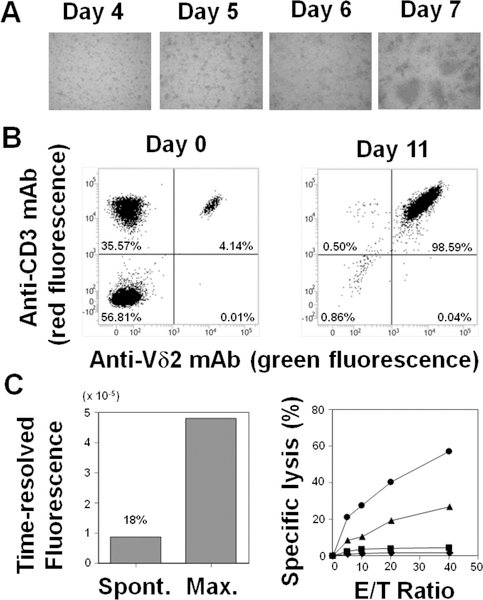Figure 4.
Immunomodulatory effects of tetrakispivaloxylmethyl-1-fluoro-2-(1H-imidazol-1-yl)ethylidene-1,1-bisphosphonate (11) on Vγ2Vδ2 T cells derived from a lung cancer patient. (A) Expansion by 11 of Vγ2Vδ2 T cells from PBMCs derived from a patient with lung cancer. PBMCs were stimulated with 11 and cell clustering was assessed on days 4, 5, 6, and 7. (B) Flow cytometric analysis of Vγ2Vδ2 T cells before (day 0) and after (day 11) expansion with 11. Cells on days 0 and 11 were stained with FITC-conjugated anti-Vδ2 mAb and PE-conjugated anti-CD3 mAb and analyzed for expression of Vδ2 and CD3 through a FACS Verse flow cytometer. (C) Specific lysis of PC-9 lung carcinoma cells by compound 11-expanded Vγ2Vδ2 T cells. (Left panel) Spontaneous and maximal time-resolved fluorescence of PC-9 cells. PC-9 cells were treated with 25 μM of BM-HT at 37oC for 15 min. After washing, the cells were incubated in the absence (spontaneous) or presence (maximum) of 0.125% detergent in DMSO for 40 min. Supernatants from the cultures were then mixed with Eu3+ solution and the spontaneous and maximum release determined by measuring time-resolved fluorescence using a PHERAStar multiplate spectrophotometer. The spontaneous release rate was 18% (Right panel) Specific lysis of PC-9 cells by Vγ2Vδ2 T cells. PC-9 cells were pretreated with 0 μM (♦), 1.25 μM (■), 2.5 μM (▲), or 5 μM (●) of 11 at 37oC for 2 h. The cells were further treated with 25 μM of BM-HT at 37oC for 15 min. The specific lysis of pretreated-PC-9 cells by Vγ2Vδ2 T cells expanded by compound 11 was determined as in Fig. 2. Data show mean ± SD and are representative of three independent experiments.

